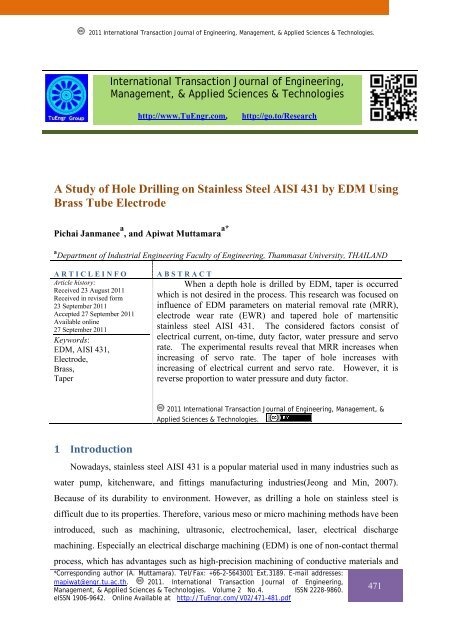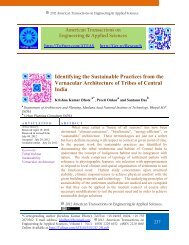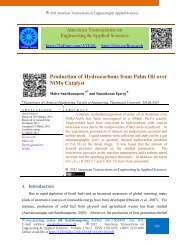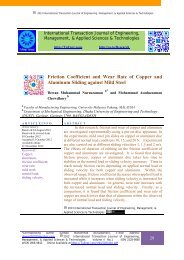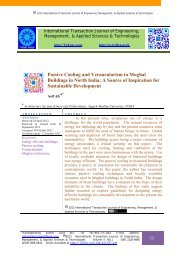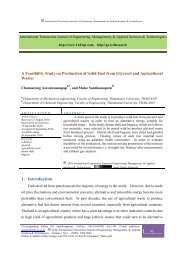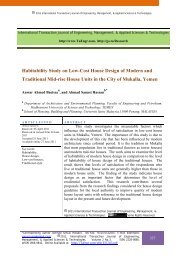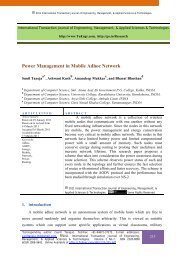A Study of Hole Drilling on Stainless Steel AISI 431 by EDM Using ...
A Study of Hole Drilling on Stainless Steel AISI 431 by EDM Using ...
A Study of Hole Drilling on Stainless Steel AISI 431 by EDM Using ...
You also want an ePaper? Increase the reach of your titles
YUMPU automatically turns print PDFs into web optimized ePapers that Google loves.
2011 Internati<strong>on</strong>al Transacti<strong>on</strong> Journal <str<strong>on</strong>g>of</str<strong>on</strong>g> Engineering, Management, & Applied Sciences & Technologies.Internati<strong>on</strong>al Transacti<strong>on</strong> Journal <str<strong>on</strong>g>of</str<strong>on</strong>g> Engineering,Management, & Applied Sciences & Technologieshttp://www.TuEngr.com,http://go.to/ResearchA <str<strong>on</strong>g>Study</str<strong>on</strong>g> <str<strong>on</strong>g>of</str<strong>on</strong>g> <str<strong>on</strong>g>Hole</str<strong>on</strong>g> <str<strong>on</strong>g>Drilling</str<strong>on</strong>g> <strong>on</strong> <strong>Stainless</strong> <strong>Steel</strong> <strong>AISI</strong> <strong>431</strong> <strong>by</strong> <strong>EDM</strong> <strong>Using</strong>Brass Tube ElectrodePichai Janmanee a , and Apiwat Muttamara a*a Department <str<strong>on</strong>g>of</str<strong>on</strong>g> Industrial Engineering Faculty <str<strong>on</strong>g>of</str<strong>on</strong>g> Engineering, Thammasat University, THAILANDA R T I C L E I N F OArticle history:Received 23 August 2011Received in revised form23 September 2011Accepted 27 September 2011Available <strong>on</strong>line27 September 2011Keywords:<strong>EDM</strong>, <strong>AISI</strong> <strong>431</strong>,Electrode,Brass,TaperA B S T R A C TWhen a depth hole is drilled <strong>by</strong> <strong>EDM</strong>, taper is occurredwhich is not desired in the process. This research was focused <strong>on</strong>influence <str<strong>on</strong>g>of</str<strong>on</strong>g> <strong>EDM</strong> parameters <strong>on</strong> material removal rate (MRR),electrode wear rate (EWR) and tapered hole <str<strong>on</strong>g>of</str<strong>on</strong>g> martensiticstainless steel <strong>AISI</strong> <strong>431</strong>. The c<strong>on</strong>sidered factors c<strong>on</strong>sist <str<strong>on</strong>g>of</str<strong>on</strong>g>electrical current, <strong>on</strong>-time, duty factor, water pressure and servorate. The experimental results reveal that MRR increases whenincreasing <str<strong>on</strong>g>of</str<strong>on</strong>g> servo rate. The taper <str<strong>on</strong>g>of</str<strong>on</strong>g> hole increases withincreasing <str<strong>on</strong>g>of</str<strong>on</strong>g> electrical current and servo rate. However, it isreverse proporti<strong>on</strong> to water pressure and duty factor.2011 Internati<strong>on</strong>al Transacti<strong>on</strong> Journal <str<strong>on</strong>g>of</str<strong>on</strong>g> Engineering, Management, &Applied Sciences & Technologies.1 Introducti<strong>on</strong>Nowadays, stainless steel <strong>AISI</strong> <strong>431</strong> is a popular material used in many industries such aswater pump, kitchenware, and fittings manufacturing industries(Je<strong>on</strong>g and Min, 2007).Because <str<strong>on</strong>g>of</str<strong>on</strong>g> its durability to envir<strong>on</strong>ment. However, as drilling a hole <strong>on</strong> stainless steel isdifficult due to its properties. Therefore, various meso or micro machining methods have beenintroduced, such as machining, ultras<strong>on</strong>ic, electrochemical, laser, electrical dischargemachining. Especially an electrical discharge machining (<strong>EDM</strong>) is <strong>on</strong>e <str<strong>on</strong>g>of</str<strong>on</strong>g> n<strong>on</strong>-c<strong>on</strong>tact thermalprocess, which has advantages such as high-precisi<strong>on</strong> machining <str<strong>on</strong>g>of</str<strong>on</strong>g> c<strong>on</strong>ductive materials and*Corresp<strong>on</strong>ding author (A. Muttamara). Tel/Fax: +66-2-5643001 Ext.3189. E-mail addresses:mapiwat@engr.tu.ac.th. 2011. Internati<strong>on</strong>al Transacti<strong>on</strong> Journal <str<strong>on</strong>g>of</str<strong>on</strong>g> Engineering,Management, & Applied Sciences & Technologies. Volume 2 No.4. ISSN 2228-9860.eISSN 1906-9642. Online Available at http://TuEngr.com/V02/471-481.pdf471
insulating materials regardless <str<strong>on</strong>g>of</str<strong>on</strong>g> material hardness, (Muttamara et al, 2009&2010). However,the important type <str<strong>on</strong>g>of</str<strong>on</strong>g> defect from hole drilling during <strong>EDM</strong> process is hole taper and holeaccuracy (Ali et al.2009). Therefore, in order to improve hole quality, Sharma et al.(2002) andBilgi et al.(2007) investigated optimum values <str<strong>on</strong>g>of</str<strong>on</strong>g> the process parameters experimentally suchas voltage, feed rate, pulse <strong>on</strong> time, duty cycle, and the length <str<strong>on</strong>g>of</str<strong>on</strong>g> un–insulate tool.Figure 1: Characteristic <str<strong>on</strong>g>of</str<strong>on</strong>g> taper <strong>on</strong> <strong>EDM</strong>In the <strong>EDM</strong> sparking hole drilling process, the viscous resistance in the narrow dischargegap causes difficulty in the removal <str<strong>on</strong>g>of</str<strong>on</strong>g> debris and bubbles from the working area, abnormaldischarges are occurred and resulting in extensive electrode wear (Yu et al. 2009). Moreover,the debris moved <strong>by</strong> pressure flow <str<strong>on</strong>g>of</str<strong>on</strong>g> dielectric fluid make taper <strong>on</strong> the workpiece. The holetaper <str<strong>on</strong>g>of</str<strong>on</strong>g> workpiece from <strong>EDM</strong> process, which as shows in Figure 1, can be calculated <strong>by</strong>equati<strong>on</strong> (1). tan(1)WhereD is hole entrances,d is hole exits, andL is hole length.This research focuses <strong>on</strong> influence <str<strong>on</strong>g>of</str<strong>on</strong>g> machining variables affecting material removal rate(MRR), electrode wear rate (EWR), and taper <strong>on</strong> martensitic stainless steel <strong>AISI</strong> <strong>431</strong>.2 Experimental ProcedureThe experiments were carried out <strong>on</strong> 35 mm <str<strong>on</strong>g>of</str<strong>on</strong>g> hole depth <str<strong>on</strong>g>of</str<strong>on</strong>g> martensitic stainless steel<strong>AISI</strong> <strong>431</strong>with ZNC-<strong>EDM</strong> model JM325DZ manufactured <strong>by</strong> Joemars company, as shown inFigure2(a). The <strong>EDM</strong> was carried out <strong>on</strong> meso-scale machining with a brass tube electrode as472 Pichai Janmanee, and Apiwat Muttamara
outside diameter <str<strong>on</strong>g>of</str<strong>on</strong>g> 1 mm, inner hole diameter <str<strong>on</strong>g>of</str<strong>on</strong>g> 0.3 mm for flushing <strong>by</strong> dielectric fluid toremove wear debris and heat ventilati<strong>on</strong> size as shown in Figure 2(b). Principle <str<strong>on</strong>g>of</str<strong>on</strong>g> tubeelectrode drilling is shown in Figure 2(c). The experiments were carried out in the de-i<strong>on</strong>ised,because <str<strong>on</strong>g>of</str<strong>on</strong>g> the advantage <str<strong>on</strong>g>of</str<strong>on</strong>g> material removal rate (Diver et al. 2004). The chemicalcompositi<strong>on</strong>s and essential physical properties are shown in Table 1 and Table 2, respectively.Table 3 shows the physical properties <str<strong>on</strong>g>of</str<strong>on</strong>g> an electrode. The experiment c<strong>on</strong>diti<strong>on</strong>s arec<strong>on</strong>tained in Table 4.(a) <strong>EDM</strong> super drill model JM325DZ(b) Brass (Cu-Zn40) tube electrode(c) ZNC-<strong>EDM</strong> drilling processFigure 2: Experimental <strong>EDM</strong> .*Corresp<strong>on</strong>ding author (A. Muttamara). Tel/Fax: +66-2-5643001 Ext.3189. E-mail addresses:mapiwat@engr.tu.ac.th. 2011. Internati<strong>on</strong>al Transacti<strong>on</strong> Journal <str<strong>on</strong>g>of</str<strong>on</strong>g> Engineering,Management, & Applied Sciences & Technologies. Volume 2 No.4. ISSN 2228-9860.eISSN 1906-9642. Online Available at http://TuEngr.com/V02/471-481.pdf473
Table 1: Chemical compositi<strong>on</strong>s <str<strong>on</strong>g>of</str<strong>on</strong>g> stainless steel <strong>AISI</strong> <strong>431</strong>.Element C Si Mn Cr Ni S PWeight (%) 0.17 0.6 1.0 17.0 2.0 0.03 0.04Table 2: Essential physical properties <str<strong>on</strong>g>of</str<strong>on</strong>g> stainless steel <strong>AISI</strong> <strong>431</strong>.PropertiesValueC<strong>on</strong>diti<strong>on</strong> Temp.( o C)Density(x1000 Kg/m 3 ) 7.8 25Elastic modulus(GPa) 200 25Tensile strength (MPa) 965 -Thermal c<strong>on</strong>ductivity(W/m – K) 20.2 100Electrical resistivity(10 -9 Ω – m ) 720 25Table 3: Physical properties <str<strong>on</strong>g>of</str<strong>on</strong>g> brass tube electrode.Properties Cu-Zn (60-40)Melting point ( o C) 910Density (g/cm 3 ) 10.98 g / cm 3Electrical c<strong>on</strong>ductivity(I.A.C.S% at 20 o C) 78~85Hardness(HRB) 93Elastic modulus (GPa) 648Table 4: Experimental c<strong>on</strong>diti<strong>on</strong>s.ParametersValuesPolarity (Electrode) +Current (A) 1-9On-time (μs) 10,30,50,90Duty factor (%) 10-90Servo rate (mm/sec) 2-10Water pressure (Kg/cm 2 ) 20-60Spindle speed (rpm) 100Dielectric fluidDe-i<strong>on</strong>ised water3 Results and Discussi<strong>on</strong>As for the experiments were c<strong>on</strong>ducted under five process factors such as ; electricalcurrent, <strong>on</strong>-time, duty factor, water pressure and servo rate, the data were analyzed as follows:474 Pichai Janmanee, and Apiwat Muttamara
3.1 Analysis <str<strong>on</strong>g>of</str<strong>on</strong>g> Water PressureThe experiments were c<strong>on</strong>ducted <strong>by</strong> varying the water pressure 20, 30, 40, 60 kg/cm 2 andfixing parameter <str<strong>on</strong>g>of</str<strong>on</strong>g> current at 9 A, <strong>on</strong>-time at 10 μs, duty factor at 75 %, and servo rate at 2 mm/sec. High water pressure has influence to cutting process makes gain <str<strong>on</strong>g>of</str<strong>on</strong>g> the drilling speed. Itincreases electrode wearing ratio but reduces taper <str<strong>on</strong>g>of</str<strong>on</strong>g> drilling wall as shown in Figure3(a-c).Because high water pressure make debris dispose out from clearance space between aworkpiece and electrode surfaces. C<strong>on</strong>sequently, complete spark <str<strong>on</strong>g>of</str<strong>on</strong>g>ten occurred and thus thematerial removal rate increased (Diver et al. 2004).(a) Effect <str<strong>on</strong>g>of</str<strong>on</strong>g> water pressure to MRR(b) Effect <str<strong>on</strong>g>of</str<strong>on</strong>g> water pressure to EWR(c) Effect <str<strong>on</strong>g>of</str<strong>on</strong>g> water pressure to taperFigure 3: Variati<strong>on</strong>s <str<strong>on</strong>g>of</str<strong>on</strong>g> water pressure with meso-hole results.3.2 Analysis <str<strong>on</strong>g>of</str<strong>on</strong>g> currentIn this experiment, we c<strong>on</strong>sider <str<strong>on</strong>g>of</str<strong>on</strong>g> each parameter <strong>by</strong> varying current 1, 2, 3, 5, 7, 9A andfixing <str<strong>on</strong>g>of</str<strong>on</strong>g> parameter <str<strong>on</strong>g>of</str<strong>on</strong>g> <strong>on</strong>-time at 10μs, duty factor at 75%, servo rate at 2 mm/sec, and waterpressure at 40kg/cm 2 . As the results in Figure 4(a), it indicates that the increase <str<strong>on</strong>g>of</str<strong>on</strong>g> materialremoval rate resulted from the raise in current. High current increases material removal rateratio and electrode wear ratio as shown in Figure 4(b) (Han et al. 2004). From Figure 4(c),*Corresp<strong>on</strong>ding author (A. Muttamara). Tel/Fax: +66-2-5643001 Ext.3189. E-mail addresses:mapiwat@engr.tu.ac.th. 2011. Internati<strong>on</strong>al Transacti<strong>on</strong> Journal <str<strong>on</strong>g>of</str<strong>on</strong>g> Engineering,Management, & Applied Sciences & Technologies. Volume 2 No.4. ISSN 2228-9860.eISSN 1906-9642. Online Available at http://TuEngr.com/V02/471-481.pdf475
taper <str<strong>on</strong>g>of</str<strong>on</strong>g> drilled hole is increased because the discharges produce thermal energy according to anelectrical current (Fukuzawa et al. 2004). As estimati<strong>on</strong> <str<strong>on</strong>g>of</str<strong>on</strong>g> the current increasing while thecross secti<strong>on</strong> is still c<strong>on</strong>stant, it makes gain <str<strong>on</strong>g>of</str<strong>on</strong>g> the density <str<strong>on</strong>g>of</str<strong>on</strong>g> current per cross secti<strong>on</strong> area (Senand Shan, 2005), (Guitrau,1997).(a) Effect <str<strong>on</strong>g>of</str<strong>on</strong>g> current to MRR(b)Effect <str<strong>on</strong>g>of</str<strong>on</strong>g> current to EWR(c) Effect <str<strong>on</strong>g>of</str<strong>on</strong>g> current to taperFigure 4: Variati<strong>on</strong>s <str<strong>on</strong>g>of</str<strong>on</strong>g> current with meso-hole results.3.3 Analysis <str<strong>on</strong>g>of</str<strong>on</strong>g> servo rateIn this experiment, we c<strong>on</strong>sider factor <str<strong>on</strong>g>of</str<strong>on</strong>g> servo rate 2, 4, 6, 8, 10 mm/sec and fix parameter<str<strong>on</strong>g>of</str<strong>on</strong>g> current 9 A, <strong>on</strong>-time at 10 μs, duty factor at 75 %, and water pressure at 40 kg/cm 2 . Asshown in Figure 5(a), it was found that the increasing <str<strong>on</strong>g>of</str<strong>on</strong>g> servo rate lead to decreasing <str<strong>on</strong>g>of</str<strong>on</strong>g> MRRbecause the spark requires an appropriate gap. If servo rate is set up over the required value,narrow gap will be occurred thus the spark is incomplete or short circuit (Choi and Kim, 1998),(Han et al. 2004). When servo rate increases, electrode wear and taper increases as shown inFigure 5(b-c). It can be explained that <strong>EDM</strong> sparking <strong>on</strong> servo rate in the narrow discharge gapchanges the c<strong>on</strong>tact angle <str<strong>on</strong>g>of</str<strong>on</strong>g> hole’s wall and the edge <str<strong>on</strong>g>of</str<strong>on</strong>g> electrode, observed in Figure 5(c).476 Pichai Janmanee, and Apiwat Muttamara
Figure 5(d) shows the phenomena <str<strong>on</strong>g>of</str<strong>on</strong>g> <strong>EDM</strong> drilling <strong>on</strong> shallow and deep holes (Yu et al. 2009).3.4 Analysis <str<strong>on</strong>g>of</str<strong>on</strong>g> Duty Factor and OnTimeThe duty factor, which means the ratio between pulse durati<strong>on</strong> and pulse cycle time exertsan important role <strong>on</strong> the performance <str<strong>on</strong>g>of</str<strong>on</strong>g> <strong>EDM</strong> as shown in Figure6 (a). In this experiment, wec<strong>on</strong>siderati<strong>on</strong> <str<strong>on</strong>g>of</str<strong>on</strong>g> each parameters <strong>by</strong> varying duty factor 10, 15, 20, 35, 45, 60, 75, 90 %, <strong>on</strong>time 10, 30, 50, 90 μs, and fixing parameters <str<strong>on</strong>g>of</str<strong>on</strong>g> current at 9 A, servo rate at 2 mm/sec, and waterpressure at 40 kg/cm 2 , respectively. As can be seen in Figure6 (b-c), the results were found thatthe each <strong>on</strong>-time was suitable for <strong>on</strong>ly a specific duty factor. MRR increases with increasing <str<strong>on</strong>g>of</str<strong>on</strong>g>duty factor <str<strong>on</strong>g>of</str<strong>on</strong>g> each <strong>on</strong>-time. However, increasing <str<strong>on</strong>g>of</str<strong>on</strong>g> duty factor leads to decreasing <str<strong>on</strong>g>of</str<strong>on</strong>g> EWR andtaper. Moreover, if increasing <str<strong>on</strong>g>of</str<strong>on</strong>g> <strong>on</strong>-time less than 30 µs, it still affects to MRR increases. At 75% <str<strong>on</strong>g>of</str<strong>on</strong>g> duty factor for <strong>on</strong>-time 30 and 50 µs, they give same values <str<strong>on</strong>g>of</str<strong>on</strong>g> MRR. However, theseparameters results in low EWR and taper.(a) Effect <str<strong>on</strong>g>of</str<strong>on</strong>g> servo rate with MRR(b) Effect <str<strong>on</strong>g>of</str<strong>on</strong>g> servo rate with EWR(c) Effect <str<strong>on</strong>g>of</str<strong>on</strong>g> servo rate with taper(d) Edge wear influence to high servo rateFigure 5: Variati<strong>on</strong>s <str<strong>on</strong>g>of</str<strong>on</strong>g> servo rate with meso-hole results.*Corresp<strong>on</strong>ding author (A. Muttamara). Tel/Fax: +66-2-5643001 Ext.3189. E-mail addresses:mapiwat@engr.tu.ac.th. 2011. Internati<strong>on</strong>al Transacti<strong>on</strong> Journal <str<strong>on</strong>g>of</str<strong>on</strong>g> Engineering,Management, & Applied Sciences & Technologies. Volume 2 No.4. ISSN 2228-9860.eISSN 1906-9642. Online Available at http://TuEngr.com/V02/471-481.pdf477
(a) Relati<strong>on</strong>s <str<strong>on</strong>g>of</str<strong>on</strong>g> duty factor and cycle time(b) Effect <str<strong>on</strong>g>of</str<strong>on</strong>g> duty factor to MRR(c) Effect <str<strong>on</strong>g>of</str<strong>on</strong>g> duty factor to EWR(d) Effect <str<strong>on</strong>g>of</str<strong>on</strong>g> duty factor to taperFigure 6: Variati<strong>on</strong>s <str<strong>on</strong>g>of</str<strong>on</strong>g> duty factor with meso-hole results.478 Pichai Janmanee, and Apiwat Muttamara
Figure 7 shows impressi<strong>on</strong>s <str<strong>on</strong>g>of</str<strong>on</strong>g> the result from the experiment test with current at 9A,<strong>on</strong>-time at 10μs, duty factor at 75%, servo rate at 2 mm/sec, and water pressure at 40 kg/cm 2 ,respectively. It shows the feature <str<strong>on</strong>g>of</str<strong>on</strong>g> taper could be achieved. Diameter at electrode entry wasbetween 1.08 mm and 0.97 mm as shown in Figure 7(a). Figure 7(b) shows result meso-holemachined exit. Figure 8 shows an image <str<strong>on</strong>g>of</str<strong>on</strong>g> a secti<strong>on</strong> meso-hole machined using the samec<strong>on</strong>diti<strong>on</strong>.(a) <str<strong>on</strong>g>Hole</str<strong>on</strong>g> entrance(b) <str<strong>on</strong>g>Hole</str<strong>on</strong>g> exitFigure 7: Characteristic <str<strong>on</strong>g>of</str<strong>on</strong>g> meso-hole and electrode results.Figure 8: SEM image <str<strong>on</strong>g>of</str<strong>on</strong>g> secti<strong>on</strong> meso-hole.4 C<strong>on</strong>clusi<strong>on</strong>As the results <str<strong>on</strong>g>of</str<strong>on</strong>g> the material removal rate, electrode wear, taper in the drill hole meso-scale<strong>by</strong> brass tube electrode, it can c<strong>on</strong>clude that:1. The MRR is lower when increasing <str<strong>on</strong>g>of</str<strong>on</strong>g> servo rate.2. The taper <str<strong>on</strong>g>of</str<strong>on</strong>g> hole increases with increasing <str<strong>on</strong>g>of</str<strong>on</strong>g> electrical current and servo rate.*Corresp<strong>on</strong>ding author (A. Muttamara). Tel/Fax: +66-2-5643001 Ext.3189. E-mail addresses:mapiwat@engr.tu.ac.th. 2011. Internati<strong>on</strong>al Transacti<strong>on</strong> Journal <str<strong>on</strong>g>of</str<strong>on</strong>g> Engineering,Management, & Applied Sciences & Technologies. Volume 2 No.4. ISSN 2228-9860.eISSN 1906-9642. Online Available at http://TuEngr.com/V02/471-481.pdf479
However, it is reverse proporti<strong>on</strong> to water pressure and duty factor.5 AcknowledgementThis work was supported <strong>by</strong> the Nati<strong>on</strong>al Research University Project <str<strong>on</strong>g>of</str<strong>on</strong>g> Thailand Office<str<strong>on</strong>g>of</str<strong>on</strong>g> Higher Educati<strong>on</strong> Commissi<strong>on</strong> and the Nati<strong>on</strong>al Research Council <str<strong>on</strong>g>of</str<strong>on</strong>g> Thailand (NRCT).6 ReferencesAli S., Hinduja S., Atkins<strong>on</strong> J., Pandya M. (2009). Shaped tube electrochemical drilling <str<strong>on</strong>g>of</str<strong>on</strong>g> goodquality holes. CIRP Annals - Manufacturing Technology , 58, 185-188.Bilgi D.S., Jain V.K., Shekhar R., Kulkarni A. (2007). <str<strong>on</strong>g>Hole</str<strong>on</strong>g> quality and inter-electrode gapdynamics during pulse current electrochemical deep hole drilling. Internati<strong>on</strong>al Journal<str<strong>on</strong>g>of</str<strong>on</strong>g> Advanced Manufacturing Technology, 34, 79-95.Choi I-H.,Kim J-D. (1998). A study <str<strong>on</strong>g>of</str<strong>on</strong>g> the characteristics <str<strong>on</strong>g>of</str<strong>on</strong>g> the electrochemical deburring <str<strong>on</strong>g>of</str<strong>on</strong>g> agovernor-shaft cross hole. Journal <str<strong>on</strong>g>of</str<strong>on</strong>g> Material Processing Technology, 75, 198-203.Diver C., Atkins<strong>on</strong> J., Helml H.J., Li L. (2004). Micro-<strong>EDM</strong> drilling <str<strong>on</strong>g>of</str<strong>on</strong>g> tapered hole forindustrial applicati<strong>on</strong>s. Journal <str<strong>on</strong>g>of</str<strong>on</strong>g> Material Processing Technology, 149, 296-303.Fukuzawa Y., Mohri N., Tani T. and Muttamara A. (2004). Electrical discharge machiningproperties <str<strong>on</strong>g>of</str<strong>on</strong>g> noble crystals. Journal <str<strong>on</strong>g>of</str<strong>on</strong>g> Materials Processing Technology, 149(1-3), 393-397.Guitrau E.B. (1997). The <strong>EDM</strong> Handbook. Handser Gardner publicati<strong>on</strong> Cincinnati, 19-54.Han F., Wachi S., Kunieda M. (2004). Improvement <str<strong>on</strong>g>of</str<strong>on</strong>g> machining characteristics <str<strong>on</strong>g>of</str<strong>on</strong>g> micro-<strong>EDM</strong> using transistor type isopulse generator and servo feed c<strong>on</strong>trol. Precisi<strong>on</strong>Engineering, 28, 378–385.Je<strong>on</strong>g Y. H., Min B. K. (2007). Geometry predicti<strong>on</strong> <str<strong>on</strong>g>of</str<strong>on</strong>g> <strong>EDM</strong>-drilled holes and tool electrodeshapes <str<strong>on</strong>g>of</str<strong>on</strong>g> micro-<strong>EDM</strong> process using simulati<strong>on</strong>. Internati<strong>on</strong>al Journal <str<strong>on</strong>g>of</str<strong>on</strong>g> Machine Tooland Manufacture , 47, 187-1826.Muttamara A., Fukuzawa Y., Mohri N., and Tani T. (2009). Effect <str<strong>on</strong>g>of</str<strong>on</strong>g> electrode Materials <strong>on</strong><strong>EDM</strong> <str<strong>on</strong>g>of</str<strong>on</strong>g> Alumina. Journal <str<strong>on</strong>g>of</str<strong>on</strong>g> Materials Processing Technology, 209, 2545-2552.Muttamara A., Janmanee P., and Fukuzawa Y.(2010). A <str<strong>on</strong>g>Study</str<strong>on</strong>g> <str<strong>on</strong>g>of</str<strong>on</strong>g> Micro–<strong>EDM</strong> <strong>on</strong> Silic<strong>on</strong>Nitride <strong>Using</strong> Electrode Materials. Internati<strong>on</strong>al Transacti<strong>on</strong> Journal <str<strong>on</strong>g>of</str<strong>on</strong>g> Engineering,Management, & Applied Sciences & Technologies, 1(1), 1-7.Rajasekhar A., Madhusudhan Reddy G., Mohandas T. (2009). V.S.R. Murti. Influence <str<strong>on</strong>g>of</str<strong>on</strong>g>austenitizing temperature <strong>on</strong> microstructure and mechanical properties <str<strong>on</strong>g>of</str<strong>on</strong>g> <strong>AISI</strong> <strong>431</strong>martensitic stainless steel electr<strong>on</strong> beam welds. Materials and Design, 30, 1612-1624.480 Pichai Janmanee, and Apiwat Muttamara
Sen M., Shan H.S.(2005). A review <str<strong>on</strong>g>of</str<strong>on</strong>g> electrochemical macro- to micro-hole drilling processes.Internati<strong>on</strong>al Journal <str<strong>on</strong>g>of</str<strong>on</strong>g> Machine Tool and Manufacture,45, 137-152.Sharma S., Jain V.K., Shekhar R. (2002). Electrochemical drilling <str<strong>on</strong>g>of</str<strong>on</strong>g> inc<strong>on</strong>el super alloy withacidified NaCl electrolyte. Internati<strong>on</strong>al Journal <str<strong>on</strong>g>of</str<strong>on</strong>g> Advanced ManufacturingTechnology, 19, 492-500.Yu Z.Y., Zhang Y., Li J., Luan J., Zhao F., Guo D. (2009). High aspect ratio micro-hole drillingaided with ultras<strong>on</strong>ic vibrati<strong>on</strong> and planetary movement <str<strong>on</strong>g>of</str<strong>on</strong>g> electrode <strong>by</strong> micro-<strong>EDM</strong>.CIRP Annals - Manufacturing Technology, 58, 213-216.Pichai Janmanee is an Assistant Pr<str<strong>on</strong>g>of</str<strong>on</strong>g>essor in the Department <str<strong>on</strong>g>of</str<strong>on</strong>g> Industrial Engineering at RajamangalaUniversity <str<strong>on</strong>g>of</str<strong>on</strong>g> Technology Krungthep (RMUTK), Bangkok, Thailand. He received a BE in IndustrialEngineering from Rajamangala University <str<strong>on</strong>g>of</str<strong>on</strong>g> Technology and ME in Producti<strong>on</strong> Engineering from King’sM<strong>on</strong>gkut University <str<strong>on</strong>g>of</str<strong>on</strong>g> Technology North Bangkok(KMUT’NB). His areas <str<strong>on</strong>g>of</str<strong>on</strong>g> research include machiningand electrical discharge machining <str<strong>on</strong>g>of</str<strong>on</strong>g> hard materials.9Dr.Apiwat Muttamara is an Assistant Pr<str<strong>on</strong>g>of</str<strong>on</strong>g>essor <str<strong>on</strong>g>of</str<strong>on</strong>g> Department <str<strong>on</strong>g>of</str<strong>on</strong>g> Industrial Engineering at ThammasatUniversity. He received his B.Eng. from Kasetsart University and the D.Eng. in Materials Science fromNagaoka University <str<strong>on</strong>g>of</str<strong>on</strong>g> Technology, Japan. His areas <str<strong>on</strong>g>of</str<strong>on</strong>g> research include machining and electrical dischargemachining <str<strong>on</strong>g>of</str<strong>on</strong>g> hard materials.Peer Review: This article has been internati<strong>on</strong>ally peer-reviewed and accepted for publicati<strong>on</strong>according to the guidelines given at the journal’s website.*Corresp<strong>on</strong>ding author (A. Muttamara). Tel/Fax: +66-2-5643001 Ext.3189. E-mail addresses:mapiwat@engr.tu.ac.th. 2011. Internati<strong>on</strong>al Transacti<strong>on</strong> Journal <str<strong>on</strong>g>of</str<strong>on</strong>g> Engineering,Management, & Applied Sciences & Technologies. Volume 2 No.4. ISSN 2228-9860.eISSN 1906-9642. Online Available at http://TuEngr.com/V02/471-481.pdf481


